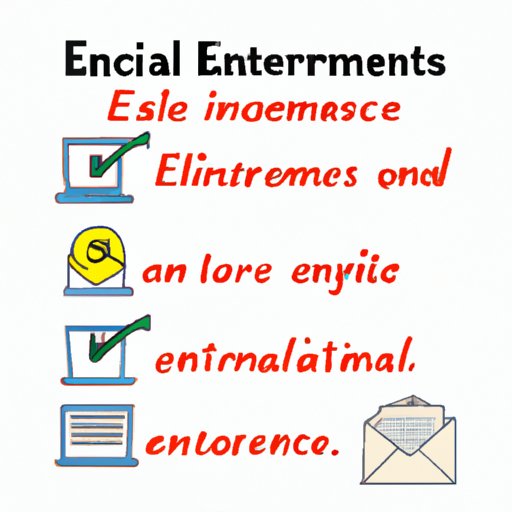
I. Introduction
Email has become an integral form of communication in the academic world. Whether you’re seeking clarification on an assignment, requesting a letter of recommendation, or just seeking advice from your professor, email provides quick and convenient access to your academic mentors. When it comes to writing an email to a professor, it’s essential to end it professionally. A proper email closing can help you establish a professional tone and make a lasting impression. In this article, we provide various tips on how to end an email to a professor.
II. Conventional Closings
Conventional email closings are the most common way to end an email to a professor. These closings are usually formal and suitable for professional academic communication. Below are the most common email closings:
- Sincerely
- Regards
- Best regards
- Yours truly
You can use these closing remarks when you are sending formal emails related to academics. For example, when you are writing a request email, asking for a reference letter, or writing a thank-you email to your professor, these closing remarks can make your email look professional. When you use them to end the email, make sure that you have made enough effort to craft the email body well, so that the closing remark can complement the tone of the content.
Example: “Thank you for taking the time to read my email. Best regards, [Your Name]”
III. Formal Closings
There are other formal email closings that can be used in academic settings. These endings can be used when sending a professional email, such as applying for a job, sending a business email, or making an official inquiry.
- Respectfully
- Yours faithfully
- Cordially
- With gratitude
If you are using a formal email closing, make sure that your email content matches the tone of the closing remark. Only use formal closings when it is suitable and necessary so that you don’t come across as too stuffy or insincere.
Example: “With gratitude, [Your Name]”
IV. Casual Closings
The use of casual email endings like “Cheers,” “Take care,” or “Thanks,” is becoming more acceptable in academic email communication, but they should be limited to specific situations and with people you’ve established a good working relationship. The appropriate use of casual closings is essential because it will help break down barriers in communication and cultivate a more comfortable conversation. It’s essential to avoid overly casual and informal closings because they may come off as unprofessional or disrespectful.
Example: “Thanks so much for the help! Cheers, [Your Name]”
V. Endings with Gratitude
In the professional world of academics, showing appreciation can go a long way in creating an excellent and lasting impression. Show that you value the time and effort your professor has put into assisting you in your academic journey. A simple “thank you” will make a lasting impact. Here are some alternative expressions of appreciation to use when you sign off your email:
- Many thanks
- Thank you so much
- Thank you for your help
- I appreciate your help
You can use these appreciation sign-offs when you are concluding a request email, a query, or when you’ve gotten a response from your professor. Expressing gratitude in your email can help establish a strong and healthy bond with your professor.
Example: “Thank you so much for answering my question! I appreciate your help, [Your Name]”
VI. Sign Off with Contact Details
Adding your contact information to the end of your email is always a good idea. By doing this, you make it easy for your professor to contact you if they have additional questions or concerns. You can include information such as your phone number or professional email address. Furthermore, adding your contact details to your email signature is an excellent way to ensure you always have the information present in all your emails.
Example: “Thanks again for your help. If you need any additional information, please feel free to contact me at [Your phone number] or [Your email address], [Your Name]”
VII. End with a Call-to-Action
Adding a call-to-action to the end of your email can help ensure that you receive a prompt response from your professor. A call-to-action can be any statement that encourages your professor to take action after reading your email. This could be requesting a meeting, seeking a response to a question, or anything that you need your professor to do after reading your email.
Example: “I would appreciate the opportunity to discuss this more in depth. Can we schedule a time next week for a brief meeting? Please let me know your availability, [Your Name]”
VIII. End on a Positive Note
It’s essential to leave a positive impression on your professor at the end of your email. Doing so can help you stand out from other students and create a lasting connection with your professor. Here are a few positive ending statements that can help you end your email on a high note:
- Looking forward to hearing back from you
- Have a great day
- Good luck with your research
- Thank you for your time and expertise
Example: “Thank you for your time and expertise. Have a great day, [Your Name]”
IX. Conclusion
Ending an email professionally is integral to making a lasting impression on your professor. In this article, we’ve provided an overview of the most common email endings, how to use them effectively, and when it’s appropriate to use them. Remember, always end your email on a positive note and use appropriate language that aligns with the content of your message. With these tips, you’ll be able to write professional and effective emails to your professor.




